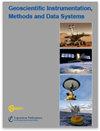MOLISENS: MObile LIdar SENsor System to exploit the potential of small industrial lidar devices for geoscientific applications
IF 2.3
4区 地球科学
Q3 GEOSCIENCES, MULTIDISCIPLINARY
Geoscientific Instrumentation Methods and Data Systems
Pub Date : 2022-08-02
DOI:10.5194/gi-11-247-2022
引用次数: 4
Abstract
Abstract. We propose a newly developed modular MObile LIdar SENsor System (MOLISENS) to enable new applications for small industrial lidar (light detection and ranging) sensors. The stand-alone modular setup supports both monitoring of dynamic processes and mobile mapping applications based on SLAM (Simultaneous Localization and Mapping) algorithms. The main objective of MOLISENS is to exploit newly emerging perception sensor technologies developed for the automotive industry for geoscientific applications. However, MOLISENS can also be used for other application areas, such as 3D mapping of buildings or vehicle-independent data collection for sensor performance assessment and sensor modeling. Compared to TLSs, small industrial lidar sensors provide advantages in terms of size (on the order of 10 cm), weight (on the order of 1 kg or less), price (typically between EUR 5000 and 10 000), robustness (typical protection class of IP68), frame rates (typically 10–20 Hz), and eye safety class (typically 1). For these reasons, small industrial lidar systems can provide a very useful complement to currently used TLS (terrestrial laser scanner) systems that have their strengths in range and accuracy performance. The MOLISENS hardware setup consists of a sensor unit, a data logger, and a battery pack to support stand-alone and mobile applications. The sensor unit includes the small industrial lidar Ouster OS1-64 Gen1, a ublox multi-band active GNSS (Global Navigation Satellite System) with the possibility for RTK (real-time kinematic), and a nine-axis Xsens IMU (inertial measurement unit). Special emphasis was put on the robustness of the individual components of MOLISENS to support operations in rough field and adverse weather conditions. The sensor unit has a standard tripod thread for easy mounting on various platforms. The current setup of MOLISENS has a horizontal field of view of 360∘, a vertical field of view with a 45∘ opening angle, a range of 120 m, a spatial resolution of a few centimeters, and a temporal resolution of 10–20 Hz. To evaluate the performance of MOLISENS, we present a comparison between the integrated small industrial lidar Ouster OS1-64 and the state-of-the-art high-accuracy and high-precision TLS Riegl VZ-6000 in a set of controlled experimental setups. We then apply the small industrial lidar Ouster OS1-64 in several real-world settings. The mobile mapping application of MOLISENS has been tested under various conditions, and results are shown from two surveys in the Lurgrotte cave system in Austria and a glacier cave in Longyearbreen on Svalbard.MOLISENS:MObile LIdar SENsor系统开发小型工业激光雷达设备在地球科学应用中的潜力
摘要我们提出了一种新开发的模块化MObile-LIdar传感器系统(MOLISENS),以实现小型工业激光雷达(光探测和测距)传感器的新应用。独立的模块化设置支持对动态过程的监控和基于SLAM(同步定位和映射)算法的移动映射应用程序。MOLISENS的主要目标是利用为汽车行业开发的新兴感知传感器技术进行地球科学应用。然而,MOLISENS也可以用于其他应用领域,例如建筑物的3D映射或用于传感器性能评估和传感器建模的车辆独立数据收集。与TLS相比,小型工业激光雷达传感器在尺寸方面具有优势(约为10 cm),重量(约为1 公斤或以下),价格(通常在欧元之间 5000和10 000)、坚固性(典型防护等级为IP68)、帧速率(典型为10-20 Hz)和眼睛安全等级(通常为1)。由于这些原因,小型工业激光雷达系统可以为目前使用的TLS(地面激光扫描仪)系统提供非常有用的补充,这些系统在范围和精度方面都有优势。MOLISENS硬件设置包括一个传感器单元、一个数据记录器和一个电池组,用于支持单机和移动应用程序。传感器单元包括小型工业激光雷达Ouster OS1-64 Gen1、一个可实现RTK(实时运动学)的双箱多波段有源GNSS(全球导航卫星系统)和一个九轴Xsens IMU(惯性测量单元)。特别强调MOLISENS的各个组件的稳健性,以支持在恶劣的野外和恶劣的天气条件下的操作。传感器单元有一个标准的三脚架螺纹,便于安装在各种平台上。MOLISENS的当前设置具有360∘的水平视野,45 \8728打开角度的垂直视野,范围为120 m、 空间分辨率为几厘米,时间分辨率为10-20 赫兹。为了评估MOLISENS的性能,我们在一组受控实验装置中对集成小型工业激光雷达Ouster OS1-64和最先进的高精度TLS Riegl VZ-6000进行了比较。然后,我们将小型工业激光雷达Ouster OS1-64应用于几个真实世界的环境中。MOLISENS的移动测绘应用已经在各种条件下进行了测试,结果显示在奥地利Lurgrotte洞穴系统和斯瓦尔巴群岛Longyerbeen冰川洞穴的两次调查中。
本文章由计算机程序翻译,如有差异,请以英文原文为准。
求助全文
约1分钟内获得全文
求助全文
来源期刊

Geoscientific Instrumentation Methods and Data Systems
GEOSCIENCES, MULTIDISCIPLINARYMETEOROLOGY-METEOROLOGY & ATMOSPHERIC SCIENCES
CiteScore
3.70
自引率
0.00%
发文量
23
审稿时长
37 weeks
期刊介绍:
Geoscientific Instrumentation, Methods and Data Systems (GI) is an open-access interdisciplinary electronic journal for swift publication of original articles and short communications in the area of geoscientific instruments. It covers three main areas: (i) atmospheric and geospace sciences, (ii) earth science, and (iii) ocean science. A unique feature of the journal is the emphasis on synergy between science and technology that facilitates advances in GI. These advances include but are not limited to the following:
concepts, design, and description of instrumentation and data systems;
retrieval techniques of scientific products from measurements;
calibration and data quality assessment;
uncertainty in measurements;
newly developed and planned research platforms and community instrumentation capabilities;
major national and international field campaigns and observational research programs;
new observational strategies to address societal needs in areas such as monitoring climate change and preventing natural disasters;
networking of instruments for enhancing high temporal and spatial resolution of observations.
GI has an innovative two-stage publication process involving the scientific discussion forum Geoscientific Instrumentation, Methods and Data Systems Discussions (GID), which has been designed to do the following:
foster scientific discussion;
maximize the effectiveness and transparency of scientific quality assurance;
enable rapid publication;
make scientific publications freely accessible.
 求助内容:
求助内容: 应助结果提醒方式:
应助结果提醒方式:


